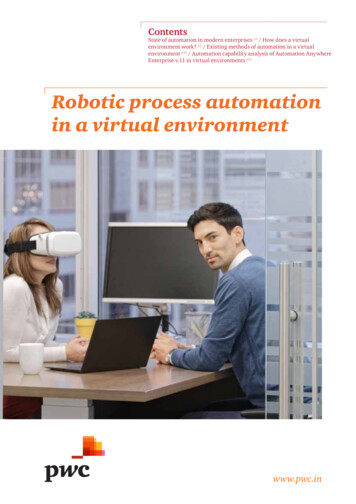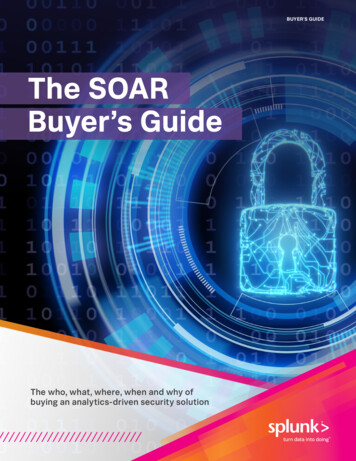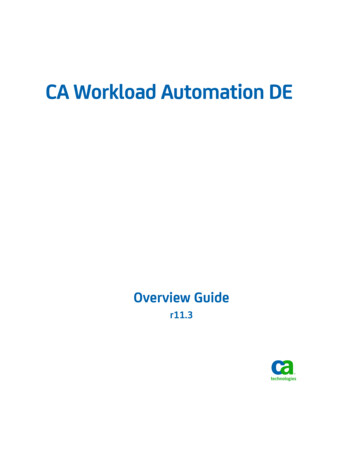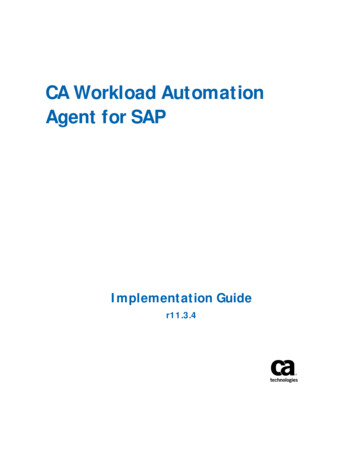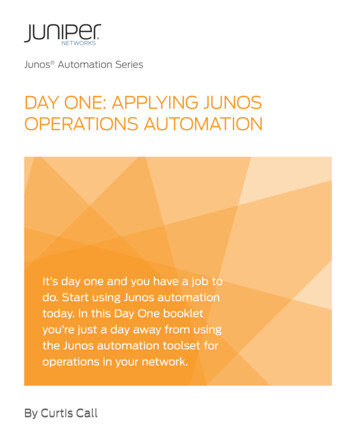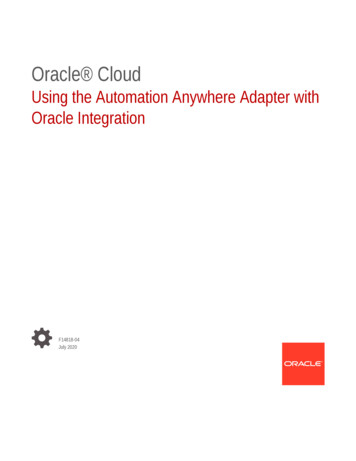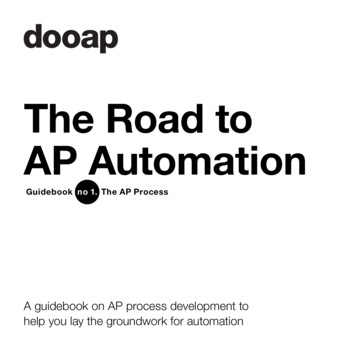
Transcription
The Road toAP AutomationGuidebook no 1. The AP ProcessA guidebook on AP process development tohelp you lay the groundwork for automation
The Road to AP AutomationAutomation has greatly impacted organizations and industries across the globe– replacing manual tasks and streamlining processes, while delivering majorfinancial benefits and competitive advantage along the way.One of the last corporate functions to be digitized, Accounts Payable is ripeto take advantage of automation and gain the same kind of efficiency, costsavings and strategic business benefits that other industries have alreadyrealized.So, what do you have to do to successfully automate AP? This series ofguidebooks will help you start the process and get you on the right path.The first booklet provides insight into AP process development to help youeffectively prepare for automation.
ContentsThe pitfalls of a partial processOptimizing your processPreparing for automation
The pitfalls of a partial processThere are many steps to invoiceautomation – from receiving invoicesand capturing them into your invoicingsystem – to coding and routing themfor approval, reviewing them and thensending them to the ERP system forpayment. All of these steps can beautomated, and when the full processis addressed, huge benefits can berealized.Yet, some companies are automatingonly parts of the process – such as usingOptical Character Recognition (OCR) torecognize characters in paper invoices,or workflow to move the invoice throughthe handling and review/approvalprocess. But the reality is that trueautomation must include all of that.So, imagine receiving an electronicinvoice that is automatically coded andentered into your invoice automationsystem, and gets routed through anelectronic workflow that generatesreminders for reviewers and enforcescompliance of your policies – such aswho can approve invoices and at whatfinancial thresholds. Imagine POmatched invoices being passed straightthrough – without human intervention –to the ERP system for processing. Then,AP staff would just handle exceptionsand have time to focus on other, morestrategic activities.Coding andMatchingWorkflowInvoiceCaptureSeamless ERPIntegration
Optimizing your processAP automation should not just beconsidered as an IT-only project.Finance and AP departments shouldalso be involved to lay the groundworkfor success. When these departmentsall work together effectively,implementation typically becomes verysmooth and straightforward.Before you automate, you shouldreview the AP process and see how itcan be optimized. On the right, thereare 3 process development tasks thatcan help you improve AP operations –regardless of whether you automate ornot:Carefully review your APprocess, with a focus onenhancing and streamliningoperations.Determine the best, mostefficient way to organize anddivide invoice processingactivities.Plan how you will implementcontrols and compliance overthe entire process.
1. Streamline the process"Stop and think aboutwhy a task is beingperformed in the firstplace."Sanna Kaarlejärvi, CFO, DooapRead Sanna’s blogTake a look at your process. Really,take a long, hard look. What isn’tworking? What needs to be changed?Are you duplicating work? Or are youstruggling with an inefficient workflow?Also, consider how often you should beperforming certain tasks in the process.For example, paying purchase invoicesfive times a week is inefficient andtime-consuming. Each time you processan invoice you have to log into thesoftware; prepare the payment batches;and check, approve and send payments.If you were to handle a large number oftransactions at once and send paymentsonly twice a week, the workload wouldimmediately be reduced by 60% – andyour vendors would still get paid on timeand never notice the difference!Before trying to automate everything,stop and think about why a task isbeing performed in the first place. If thetask is unnecessary, then you shouldjust stop doing it – which would notonly streamline the process, but alsoavoid the unnecessary time and cost ofautomating it.
2. Dividing the workloadBefore automating a process, you needto make decisions on work divisionbetween the AP department (or financeteam) and the invoice reviewers andapprovers in the business units.Bear in mind that the AP processinvolves many busy people in thebusiness units. In fact, when companiesperform efficiency calculations, thetime spent on financial managementtasks outside the finance team is rarelyconsidered, even if the cost related to itmight be significant.Our recommendation, based onhundreds of process developmentcases, is to centralize as much of theAP-related work as possible. And, here’swhy:1.2.3.Centralized processing enables masshandling, which is always more efficientthan handling single transactions, sincegetting started always takes moretime. Centralized processing helpsto effectively identify repetitive andrecurring events which can then beautomated. If an approver only handlesone or a few invoices a month, thereis not a lot of motivation to improveefficiency. However, when the AP teamhandles 20 or more similar invoicesper month, there is a clear benefit toimproving the invoicing process.Centralize invoice coding and taxoperations with the finance team.This is where the experts reside who aretrained and experienced in bookkeepingand taxation. Coding purchaseinvoices in the approval workflow canbe burdensome for invoice reviewersacross the organization, who typicallyview it as a difficult, boring task thatgets performed under pressure, as theinvoice due date approaches. Theyoften code an account based on a guessor the (possibly wrong) coding of aprevious similar invoice. When coding iscentralized in the finance department,not only is the quality of bookkeepingimproved, but the cumulative time spenton coding is reduced as well as the timeto process invoices.The number of invoices requiringapproval can be greatly reducedby matching them against POs andcontracts. Some companies routethese matched invoices to the reviewerand approver to keep them informedof the cost – even though there are nodiscrepancies. Consider a companythat routes telephone bills to everydepartment head so that they are awareof – and can control – the chargesbooked to their cost centers. Processingan invoice this way is very costly, andcan result in delays that can causelate payments and penalties. A betterprocess would be to centrally approvethe invoice to be paid, and make surethat all business units are informed ofit in their cost reports so they can keeptelephone costs within agreed-uponlimits.
3. Gain control and complianceControl and compliance is a criticalconcern of all organizations.Consider the internal policies thatyou need to implement to effectivelycontrol AP and avoid fraud. Do youneed to have two approvers oninvoices of a certain dollar amount?Who can add new vendors? Howare duplicate invoices identified?How are exceptions reported andhandled?Now, think about where you’reconducting business and all theregulations that you need to complywith in all of these areas – e.g., VATtaxes, SOX, 1099, GAAP etc. Thesecan be built into your automatedsystem. And, by implementing strictcontrols, you also help deter fraud.
Preparing for automationThree steps to consider before beginning process automationDigitizing the dataThe more you receive invoices instructured and digitized format,the better. Go through your invoicereceipt methods, and improve themas much as possible.For more detailed instructions,see our Guidebook no 2.Developing a matching planTo optimize invoice automation,also make sure you establish asound process for purchasing. Byestablishing effective purchase orderpractices, accurate invoices can beautomatically matched against them,bypassing the approval process.The same method can be usedwith recurring and contract-basedinvoices.Considering Robotic ProcessAutomation (RPA)RPA can be a good addition toinvoice automation. The benefits ofRPA are best seen with tasks thatrequire lots of manual input work.RPA is particularly suited for tasksthat are too small, irregular or fastchanging to be automated usingtraditional systems, such as invoiceentry and posting.For more information, see our RPAGuidebook.
The fast track to world-class APFor AP professionals who arealready on the journey, the benefitsof AP automation are undeniable.By evaluating current processes andplanning carefully, you too can beon your way to enjoying the costsavings, efficiency and control thatautomation brings to the invoicepayment process.Are you ready to join the ranks ofworld-class AP departments, get onthe fast-track to savings and gaincritical competitive advantage?
2The Road toAP AutomationGuidebook no 2. The InvoiceA Guidebook to Move YourInvoices from Paper to Digital
Moving from Paper to DigitalAccounts payable automation provides so many advantages – it’s more efficient,accurate and cost-effective. But before you can automate, it’s important toget your invoicing house in order. Otherwise, you’ll continue dealing withproblematic, poor-quality invoices and won’t truly benefit from the productivitygains and cost savings that automation has to offer.When it comes to invoices, it’s all about the data. The type of data, the formatand the way that the data is captured are all things to consider as you transformyour invoices from paper to digital and prepare for automation.This guidebook explains how you can digitize and improve the quality of yourinvoices as you get ready to automate. This guidebook – along with Guidebook 1on The AP Process – will get you on the right path on your automation journey.
ContentsFrom paper to digitalIt’s all about the dataWhich format is best for your organization?Making sense out of the data – image captureWhy e-invoices are the way to goBe a part of the invoicing ecosystemTake the plunge
It’s all about the dataStructured dataBefore we dive into the actual invoices, it’shelpful to consider the two different typesof data that are in them – structured andunstructured.Structured dataThis type of data – which is foundin spreadsheets for example – isstructured in a way that makes theinformation easily searchable by anautomated system.Unstructured dataThis is raw and unorganized data thatlacks a basic structure, which makessearch and information retrieval difficult.Text files, PDF, emails, social media andaudio and video files are common formsof unstructured data.Why does the data structure matter?The processing system needs to receiveinvoices in a structured data format inorder to automate invoice processing.If the data is unstructured, you need tomanually input it into to a digital formator use Optical Character Recognition(OCR) software.Unstructured data
Which format is best for yourorganization?Invoices come in different types and formats.Understanding the differences between themand which is best for your organization is akey first step in improving invoice quality:1. Paper invoices – Unfortunately, weare all too familiar with paper invoicesand many AP departments are buriedunderneath them. These paper invoicescan easily get misplaced, or lost, whichcan result in late payments and penalties.On top of that, processing paper invoicesis very inefficient. Because these invoicescontain unstructured content, AP staffmust spend a lot of time manuallyinputting the invoice data into a digitalformat for processing, which introducesthe risk for human error. In short, paperinvoices take too much time, and thefaster you can move away from them, thebetter.2. PDF invoices via email – PDF imagesof the invoice sent by email are a slightstep up from paper invoices because theycannot be altered, reducing the potentialfor fraud. When they are sent by emailthey also have a slightly lower chanceof getting lost. But, these invoices alsocontain unstructured data, so AP staff stillneeds to spend the time capturing andinputting the data into their processingsystem, and that has the same problemsassociated with manual processes.3. EDI. Because the data in EDI isstructured, it reduces the need tocapture information from the invoiceimage. However, because EDIconnections are usually set up pointto-point and the information is notcomplete, buyers and suppliers alikemust pay attention to the contents andmapping so the data is being received inthe correct columns.4. E-invoices are the ideal invoiceformat. An e-invoice contain the actualimage along with structured XMLinformation that a company needsto process the invoice through anautomated system. While there aremultiple e-invoice formats available,the network operators that delivere-invoices between trading partnerstake care of mapping between differentformats, so companies can alwaysreceive the invoice in the format thatbest fits their needs.
Making sense out of the data– image captureThe road towards automation ande-invoicing doesn’t usually happenovernight; getting rid of paper invoices takestime. That’s why you’ll need to improve theprocess and convert your paper and PDFinvoices to a digitized format. The first stepis to capture the data through an automatedprocess. There are two main approaches todoing this:OwnOptical Character Recognition (OCR)software recognizes characters inpaper and PDF invoices. It is typicallybased on recognizing key words andteaching the software where the datalies in different invoice templates.However, teaching the OCR itself andemployees to use it takes a lot of timeand resources. And to maintain the levelof quality high, manual validation isrequired.RentCapture as a Service (CaaS) – Thisis essentially the same as owning thesoftware, but it outsources the process,and frees up the company from havingto complete the time-consuming work.Service providers focusing on CaaShave already built the invoice templatesand taught the software – for years. Thismeans that you get to reap the benefitsof high-quality data capture immediatelyand focus your time on more strategictasks.Regardless of which of the twoapproaches you use, you need tore-examine the cost-rewards benefitsbehind it. Having OCR technologyin-house is not part of most APdepartments’ core competencies andmight not be a smart investment sincepaper and PDF invoices, which are onthe decline, may ultimately be phasedout.
Why e-invoicesare the way to goBe a part of theinvoicing ecosystemStructured data content is at thecore of effective invoice automation.Because of the time and cost savings,decreased errors, and greater controlover payments that e-invoices deliver,it’s worthwhile to put in the time nowto transform your paper invoices toe-invoices.Once you create e-invoices, a wholenew universe of options is available.You can send and receive e-invoicesinstantaneously anywhere aroundthe world through the many, ofteninterconnected invoicing networks. It notonly makes everything transparent, butit also dramatically speeds up the entireprocess.You will need to work with your suppliersto help them transition to e-invoices.And you can educate them on howe-invoices enable faster processing,and potentially faster payment. By doingthis, you not only improve supplierrelationships, but you will also achievegreater internal customer satisfactionwith the AP department, which will befree from the manual, time-consumingprocesses and can now focus on moremeaningful, strategic activities.And don’t forget, you’re not only apurchaser but you’re a supplier as well.You can also make changes in yourAccounts Receivable department tomake sure you are sending e-invoicesto your customers. That way, you’re notonly doing the right thing and payingit forward, but you’re also helping tospeed up the process when you getpaid. After all, e-invoices offer a win-winscenario.
Take the plungeE-invoices are the ideal solution for movingfrom a paper to digital AP process – it’sas simple as that. Why spend time andmoney trying to process paper, when youcan automatically get the data you needelectronically? It opens a whole new world ofgreater efficiencies, cost savings, increasedquality and improved supplier relationships.We’ve seen the futureand it’s digital. Are youready to join us?
3The Road toAP AutomationGuidebook no 3. AP Automation from the IT PerspectiveA Guidebook to Move YourInvoices from Paper to Digital
ContentsAP automation from the IT PerspectiveAP automation in the cloudDon’t settle for partial automationWhat should you consider when choosing an AP automation solution? Implementation Operations D365/AX upgradesAP automation: Easy to implement, operate and upgrade
AP Automation in the cloudOrganizations are quickly embracingthe cloud because of the manybenefits it offers – it’s flexible, easyto manage, and available fromanywhere – and it’s no wonder thatAP departments are getting on thebandwagon.After all, if you’re already moving to thecloud, you should take your invoices withyou. It’s an ideal solution for enabling themobile workforce to access and approveinvoices digitally, anywhere, anytime.While cloud initiatives may be AP-driven,IT also has role to play in ensuring thatcloud-based AP solutions and upgrades arealigned with the organization’s technologystrategy and existing infrastructure orecosystem.This guidebook covers the role of IT inestablishing AP automation in the cloud, andthe issues CIOs and IT professionals shouldconsider as they make this digital transition.Designed for CIOs and IT departmentsrunning Dynamics 365 or AX2012, thisguidebook – AP Automation from the ITPerspective – is a companion to Guidebook1 on the AP Process, and Guidebook 2 onThe Invoice. Together they will help yourorganization effectively transition to APautomation and reap the productivity gainsand cost savings that it delivers.
Don’t settle for partial automationAutomation can mean a lot of differentthings to a lot of people, but one thing that’sclear is that when it comes to AP processimprovement, the more automation, thebetter. When you break down the invoicehandling process, it is comprised of manysteps – from invoice receipt and capture,to PO matching, coding and routing forapproval, review and transfer to an ERP forpayment and analytics.Why not automate the entireprocess?Some companies are just automatinga partial process, like OCR (OpticalCharacter Recognition) to recognizethe characters in an invoice. While theywill save some time and gain someefficiency, it’s minimal compared towhat they could achieve by automatingthe entire process – from beginning toend. But, by going to the cloud, you cantake a holistic approach and automateOCR, workflow, coding and matching,all with a solution that is seamlesslyintegrated with your ERP, to maximizeyour business benefits. That will providegreater efficiencies, reduce errors andstreamline the invoice handling process.No more headachesA key benefit of end-to-end automationis that you have always the accessto your master data that you need forapproval workflow, including codingand matching. Your vendor register,chart of accounts, sales tax codes,POs, product receipts, and more areall maintained and available in realtime on D365/AX. This not only avoidsthe headache of duplicate data, but italso supports a streamlined and fasterinvoicing process. For example, thegoods received can be authenticated inreal time from the master data, enablingPOs to be quickly matched to invoices.And, as part of the Microsoft ecosystemyou have easy access to Azure Storageand can take advantage of Azure AD.A safe pair of handsWhat does this mean for IT? It meansthat it is as easy as possible. Thereare no integrations to worry about,and future D365/AX upgrades can gosmoothly without problems caused bybroken integrations.
Your checklist when choosingan AP automation solutionImplementationConsider the three aspects of deploymentIt’s never been easier to implement AP automation than in thecloud. It represents a drastic shift in responsibility for systemimplementation, with AP being responsible for 90% of it, and ITonly 10%.implementationoperationsupgradesIT doesn’t have to spend much time ormany resources on deployment, sinceit only has to connect the solution –which automatically integrates to themaster data – and add a few accounts.Together, these tasks would take only afew hours vs. the days it would take todeploy an on-premise solution.Streamlining your implementationis as easy as 1-2-3:Keep it simple. Try to avoidcustomizing your D365/AXsystem, so upgrades will be morestraightforward. It’s important thatthe AP automation solution youchoose is compatible and validatedby your Dynamics partner andMicrosoft.Use the master data in your D365/AXsystem. It’s easy when all your datais maintained and available in onecentral place.Implement your AP automationthrough Microsoft Lifecycle Services(LCS).
OperationsD365/AX UpgradesThe cloud makes operations easier than ever:So, you’ve transitioned to AP automation in the cloud andeverything is running smoothly, but what happens when it’s timeto upgrade your D365/AX system? The good news is that nothingmuch changes – and IT isn’t required to do much:System Maintenance. IT doesn’thave any new responsibilities formaintaining and monitoring APautomation. Updates are madeautomatically to the AP automationsystem through LCS, requiringminimal IT involvement, and theydon’t affect D365/AX systemoperations.Security. When the data is in thecloud, it is protected with D365/AXsecurity, so no additional security isneeded.Uptime: AP automation is coveredby the Microsoft Azure SLA, and ishoused in the same data center withthe same uptime as D365.Support: IT does not need totake on any additional supportresponsibilities since the invoiceautomation system is implementedas one package in LCS, whichprovides a standardized way todeliver D365 extensions. Withresponsibility falling almost entirelyon the AP department, the roleof IT is even less than it is forimplementation.When you upgrade to a newer versionof D365, it’s as easy as it can be.You simply get a new plug-andplay compatible version of your APautomation software from LCS in thecloud.And, even a major upgrade fromAX2012 to D365 is easy because LCSautomatically delivers compatibleversions to the invoice automationsystem. Similarly, upgrades – or anyD365/AX customizations for thatmatter – won’t impact AP automationin the cloud. You can continue usingyour automation system seamlesslyas always, and the user interface willlook and feel the same. The upgradetakes minimal IT time and resources.When you purchase your APautomation solution, make sure it’scompatible with D365/AX so youcan avoid the time, effort and cost ofcustomizing it. But if you do requirecustomization, you can outsourceany compatibility issues to your ISV.Security and support: No additionalsecurity or support is neededbecause everything is implementedthrough LCS.While IT and the AP departmentwould work together on an upgrade,the role of IT is minimal.
AP Automation:Easy to implement, operate and upgradeAP automation on D365/AX is easy and requires minimal ITinvolvement. The master files, security, upgrades, and more areall implemented through Microsoft’s LCS in the cloud, so the ITdepartment is freed up to focus on other activities.The ease and flexibility of the cloud – not to mention easy access toyour AP automation solution from anywhere, anytime – makes it anideal solution for IT and AP departments alike.Are you ready to make your work easier, more efficient and better?Hop on the cloud with us!
4The Road toAP AutomationGuidebook no 4. Harnessing ChangeA Guidebook to Move YourInvoices from Paper to Digital
The Road to AP Automation1. The AP Process2. The Invoice3. The IT4. Tackling Change5. The Future
ContentsHarnessing Change –Bringing the Value of AP Automation toYour OrganizationDon’t Overlook the Importance of Change ManagementProcess Development as Part of the IT DepartmentThe Changing AP FunctionTips for Providing Better Service to the OrganizationTackling Organization-wide Change
Congratulations!Yes! Finally you made the decision to moveto invoice automation and benefit fromstreamlined processes, efficiencies andreduced costs. The next step is figuring outhow to successfully make the transition.A key challenge you face:people just don’t like change.While change can seem difficult, it doesn’tneed to be. This guidebook lays out thesteps for moving from paper-based, manualprocesses to automated ones in the easiest,most effective way. It also provides tipson how to engage the AP department andothers on this journey to bring them alongwith you.
Don’t Overlook the Importance ofChange ManagementLet’s face it, people often resist change.We are all creatures of habit, and howpeople react can be a key factor inwhether or not a new technology willbe successful. Even with the best,most advanced technology in theworld, if people don’t use it, or don’tuse it correctly, then the value of thetechnology can’t be realized.Making the move from manual processesto automation can feel like a big change.But if you can get users on board, youcan make the transition smoother.There are three key strategiesto help your AP staff embraceautomation:1. Engage Users Early and OftenHelp users see what automation willmean for your organization. Before youtalk specifics, talk about the “why” – whyyou are introducing new technologyand processes, what you are hopingto accomplish, and what problems youare trying to overcome. You need toexplain how this will make the life of APprofessionals easier and better.2. Establish a Sense of TrustIt’s important to gain the trust of users.AP staffers need to feel confident thatthe new system will work well and willprovide valuable benefits. They need toknow that they can rely on the system,and that their documents will be keptsafe and accessible in the digitalarchives.Trust comes from knowledge andunderstanding. Set up system trainingso your staff can learn how the systemworks and its functionality. And, provideopportunities early on to allow them tojump in and experience automation forthemselves. This will go a long way togetting them on board.3. Explain What the Change WillMean for ThemWith any type of change, users want toknow what it will mean for them. Makesure you address that issue so theyknow what to expect.AP automation primarily impacts thefollowing stakeholders:AP and financial managementpersonnel. As automation makespaper-based processes and timeconsuming routine tasks becomea thing of the past, it changes howAP and financial professionalswork and what they do. Now, theseprofessionals can use their time tofocus on exception handling andprovide better service and supportto the greater organization. You canhelp them by making user interfacesand processes as easy andstreamlined as possible to improvetheir user experience.Invoice reviewers and approversacross the organization. Whilereviewers/approvers only dealwith invoices periodically, they canbe an unwelcome interruption totheir work. Try to simplify invoicereview and approval so theseprofessionals can focus on their coreresponsibilities instead of financialmanagement.
Process Development as Part ofthe IT DepartmentThoughtful planning and a holistic view ofprocess development every step along theway will provide the best results. Considerthe invoicing process and workflow beforeyou begin developing the specifics of thesystem so you can maximize the benefitsusers will realize from the new digital system.2.1.Develop a plan forefficient and effectiveprocesses. Considerworkflow and AP issuesto determine processesthat will work best.Start specifying thesystem. Identifysystem capabilities tosupport your plannedprocesses.3.Develop thesystemaccordingly.4.There are five key steps tointegrating process developmentwith the IT process:Test the system in action to makesure it supports the plannedprocesses. Provide descriptionsfor particular jobs and tasks.Provide training on the newprocesses.5.Make sure that processchanges are properlyimplemented. Looktoward continuousprocess improvement.
The Changing AP FunctionTips for Providing Better Service to the OrganizationChanging business needs, along with the availability of advancedinvoice technology, is transforming the very role and function of APprofessionals.Another benefit of streamlining APprocesses is that it enables AP to providegreater support and service to theorganization as a whole. The reality isthat the people outside of AP also spendHere are two ways that is happening:Here are several strategies for achieving this:1.2.Elevated role of AP. Thanks to automation, AP is no longer a back-officefunction performing routine tasks, but isfast becoming a respected and integralpartner to other departments in theorganization, including finance and accounting. At the same time, AP professionals are assuming more strategicresponsibilities, including reporting andanalysis, rather than focusing on recording and reviewing all transactions.Strategic focus on AP. Automationprovides an exciting opportunity fororganizations to review and refreshthe entire AP “job description.” Asthey embrace automation and let goof time-consuming manual tasks, APprofessionals can turn their sights onstrategic priorities where they can addcritical value to the business.Centralize as many of the tasks aspossible with the finance team – e.g.coding and tax handling.At the same time, it is more efficient tocentralize invoice processing in a SharedServices Center than in multiple areasacross the organization.Minimize the number of invoicesrequiring approval through automaticmatching against purchase orders andcontracts.Don’t waste time on low-value orunnecessary tasks. For example, there’sa significant amount of time on financialmanagement. Automation presents anopportunity for AP to reduce the timeand burden of these financial tasks in theorganization as a whole.no need for four people to r
practices, accurate invoices can be automatically matched against them, bypassing the approval process. The same method can be used with recurring and contract-based invoices. Considering Robotic Process Automation (RPA) RPA can be a good addition to invoice automation. The benefits of RPA are best seen with tasks that




